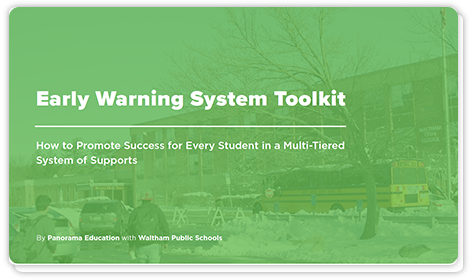A K-12 early warning system is more than just a technology platform. For an early warning system (EWS) to truly change student outcomes, it's essential to build human processes and protocols around taking action on the data to support at-risk students.
School leaders and educators at McDevitt Middle School (Waltham, Mass.) know this well. Over the last year and a half, school teams at McDevitt—led by Principal Mike Sabin—have operationalized the use of early warning indicators across the school. From structured EWS meetings to action planning protocols, McDevitt has taken a multi-pronged approach in order to equip educators with the knowledge and tools they need to change outcomes for each and every student.
Drawn from McDevitt's playbook, here are the six keys to a successful school-wide EWS implementation within a multi-tiered system of supports (MTSS).
"An early warning system is a great tool to use to focus on our neediest students, but the systems don't run themselves. Dedicated leaders, teachers, and advocates are needed at the school level to translate the research and data into our daily practices to help students."
–Mike Sabin, Principal, McDevitt Middle School
6 Tips for Easier EWS Implementation
1. Find Early Warning Indicator (EWI) Champions
Identify school leaders, teachers, or counselors who are passionate about promoting the early warning indicator philosophy, sharing the latest research, and driving the work forward across the school. These individuals will be able to champion the work amongst their colleagues, share successes, and provide perspective on how to create the most impact for students through early warning work.
2. Use an Early Warning Platform
Give teachers and staff access to an integrated data system that updates daily with students' indicators across academics, behavior, attendance, and life skills. Educators should be able to access insights about students in one click, and the data should be easy to understand at first glance. That way, educators can spend less time wrangling with data and more time on the ground supporting students.
3. Create a Collaborative EWI Meeting Schedule
Dedicate time for staff members to organize around EWI work. For example, at McDevitt Middle School, educators and staff are divided into eight grade-level teams, or clusters, that each meet once a month. These meetings are part of the existing middle school meeting structure. During the meetings, cluster members follow a set agenda to review the EWI data and design action plans for students who are slipping in the ABCs (attendance, behavior, coursework).
For more strategies and resources, download Panorama's "Early Warning System Toolkit."
4. Foster Strong Meeting Facilitation
Develop school leaders' and faculty members' capacities to lead EWI meetings. Assign a facilitator for each meeting who will use protocols to define action steps and check-in points to track progress. Ideally, the facilitator will be skilled at ensuring that conversations are productive and grounded in data.
5. Seek District-level Support
Even if you're adopting an early warning system at a school site, it's important to cultivate buy-in at the district level to ensure a smooth implementation process. District leaders will be able to provide resources, strategic guidance, and technical support as your school works to build early warning work into its day-to-day practices.
6. Develop an Intervention Strategy
Data inquiry is only the first step; focus everyone's efforts on interventions and support planning to get students back on track for success. To keep staff accountable, set goals and deadlines for executing the support plans. Here, you can download the intervention action planning worksheet that McDevitt's educators use to plan supports for individual students.
Conclusion
Implementing a K-12 early warning system will look different at every school and district, but the above framework will help your team design an effective early warning program that improves student outcomes. Download our Early Warning System Toolkit to learn more about bringing an early warning system to your campus!



.png)



